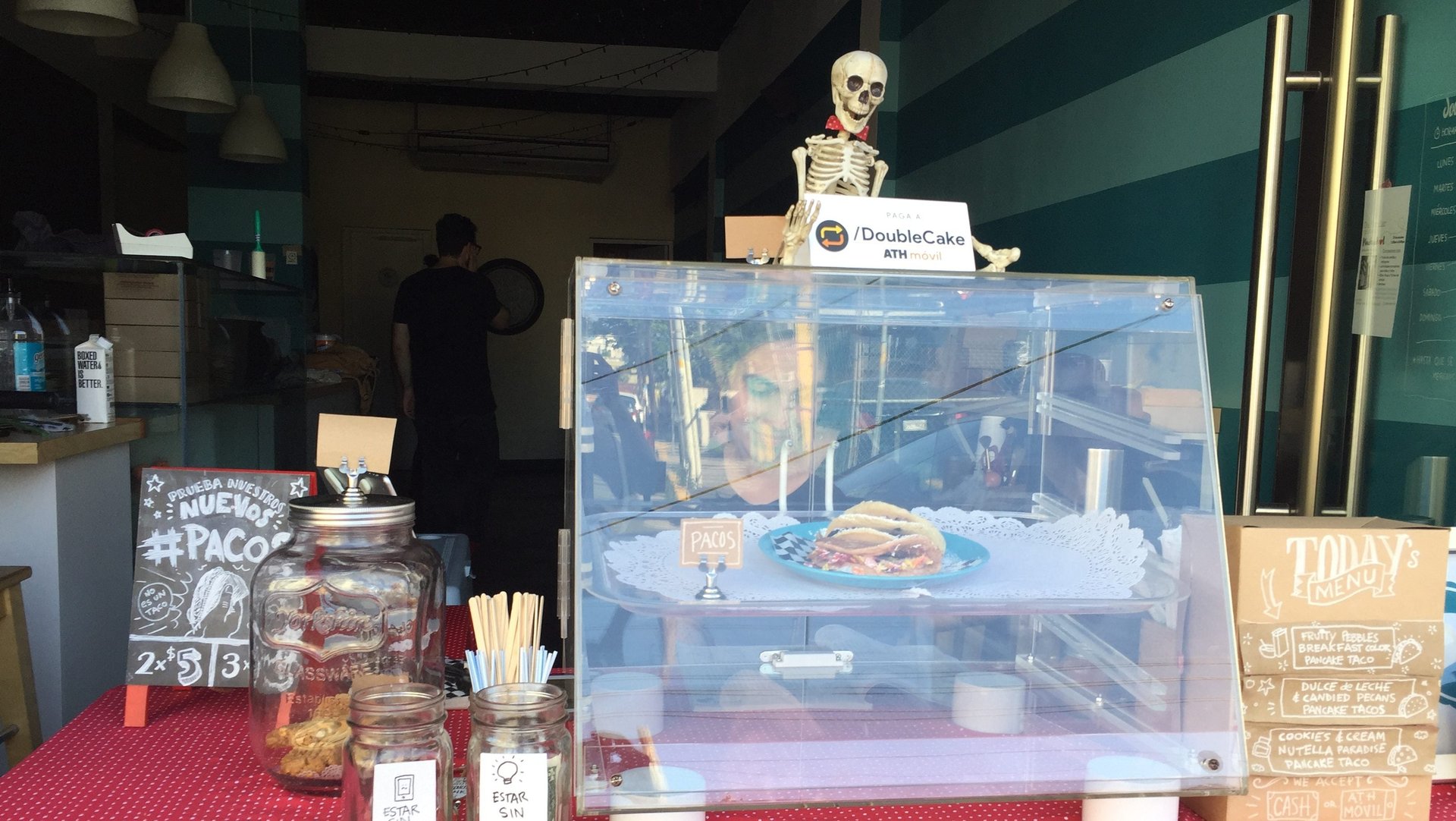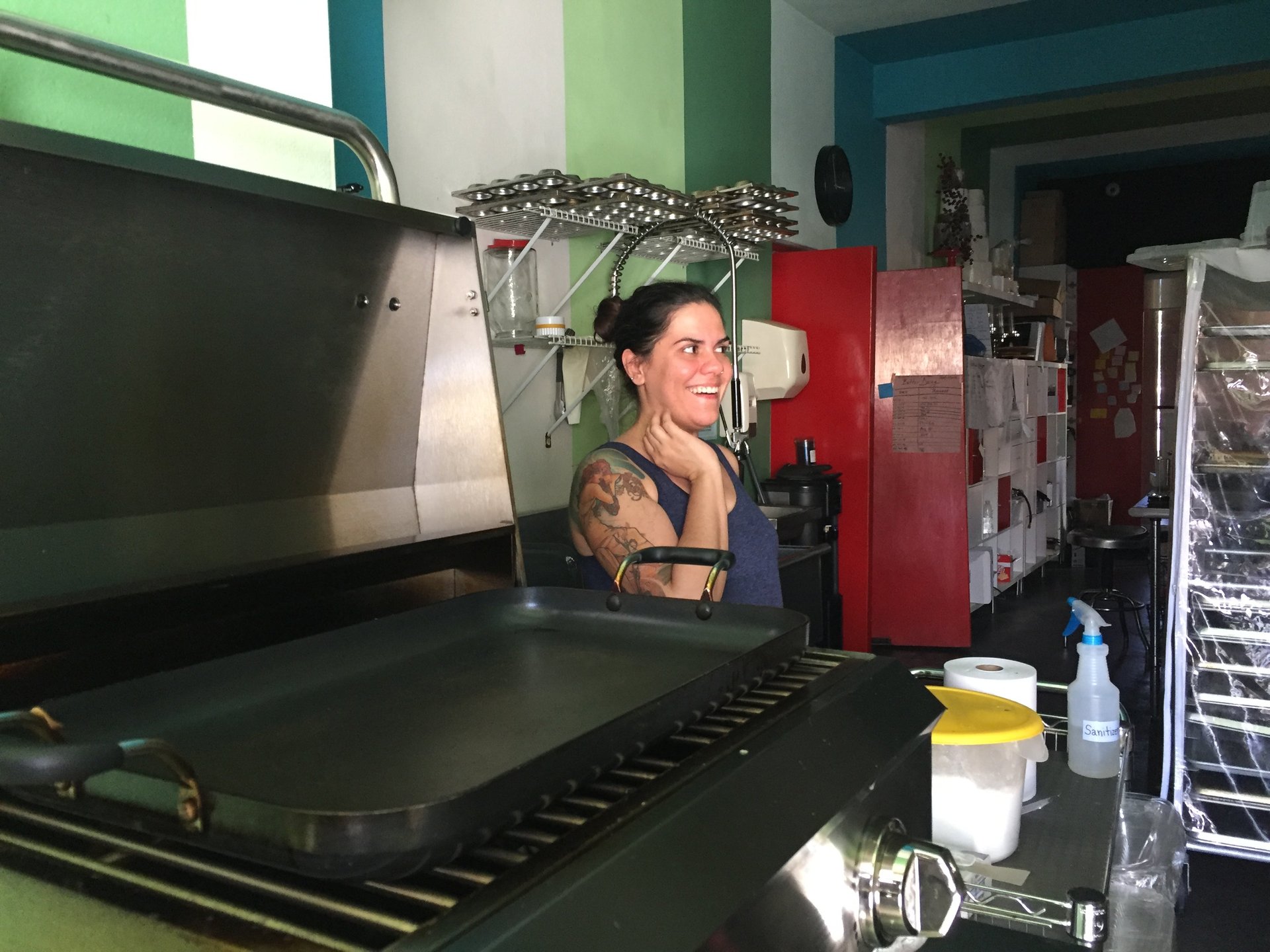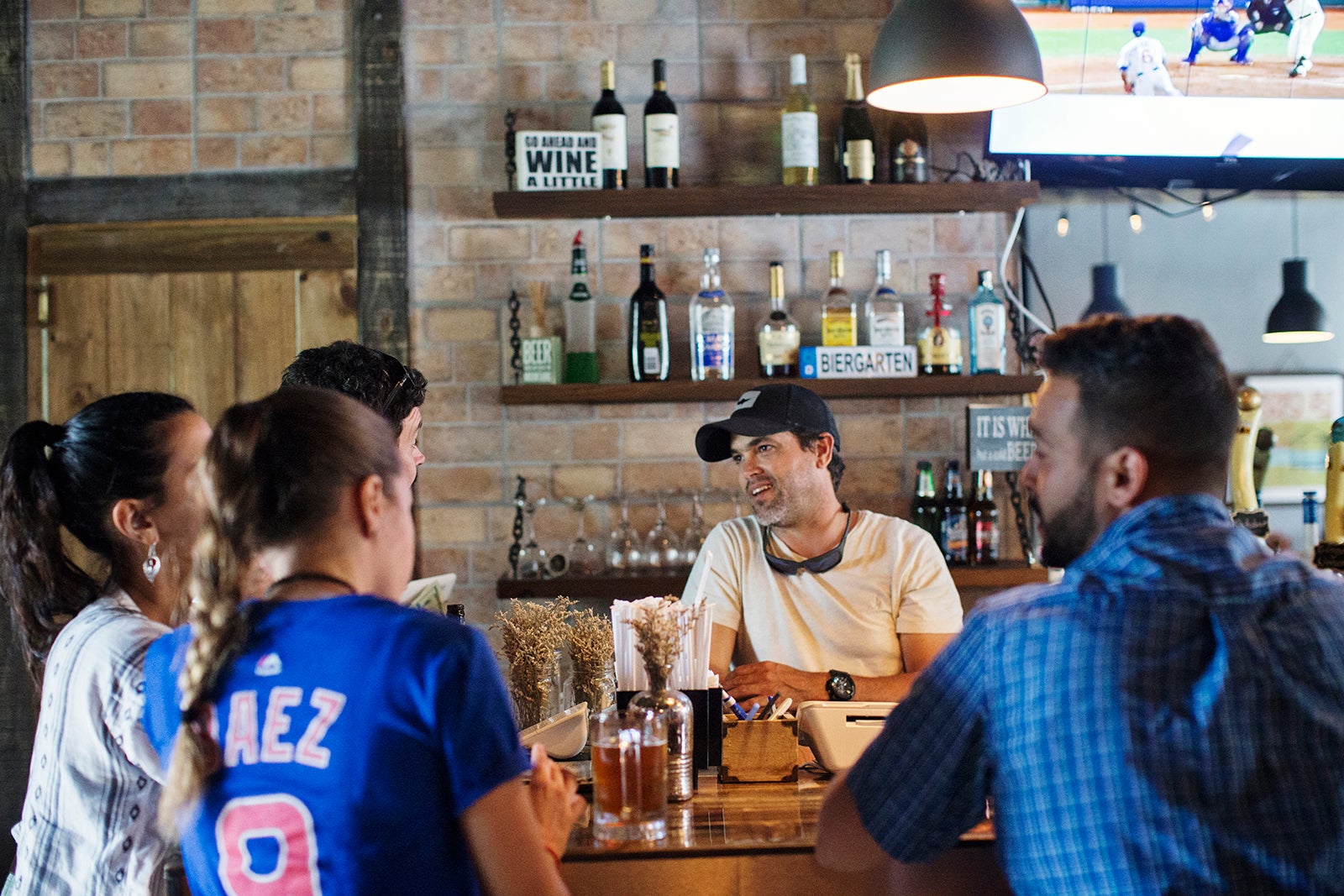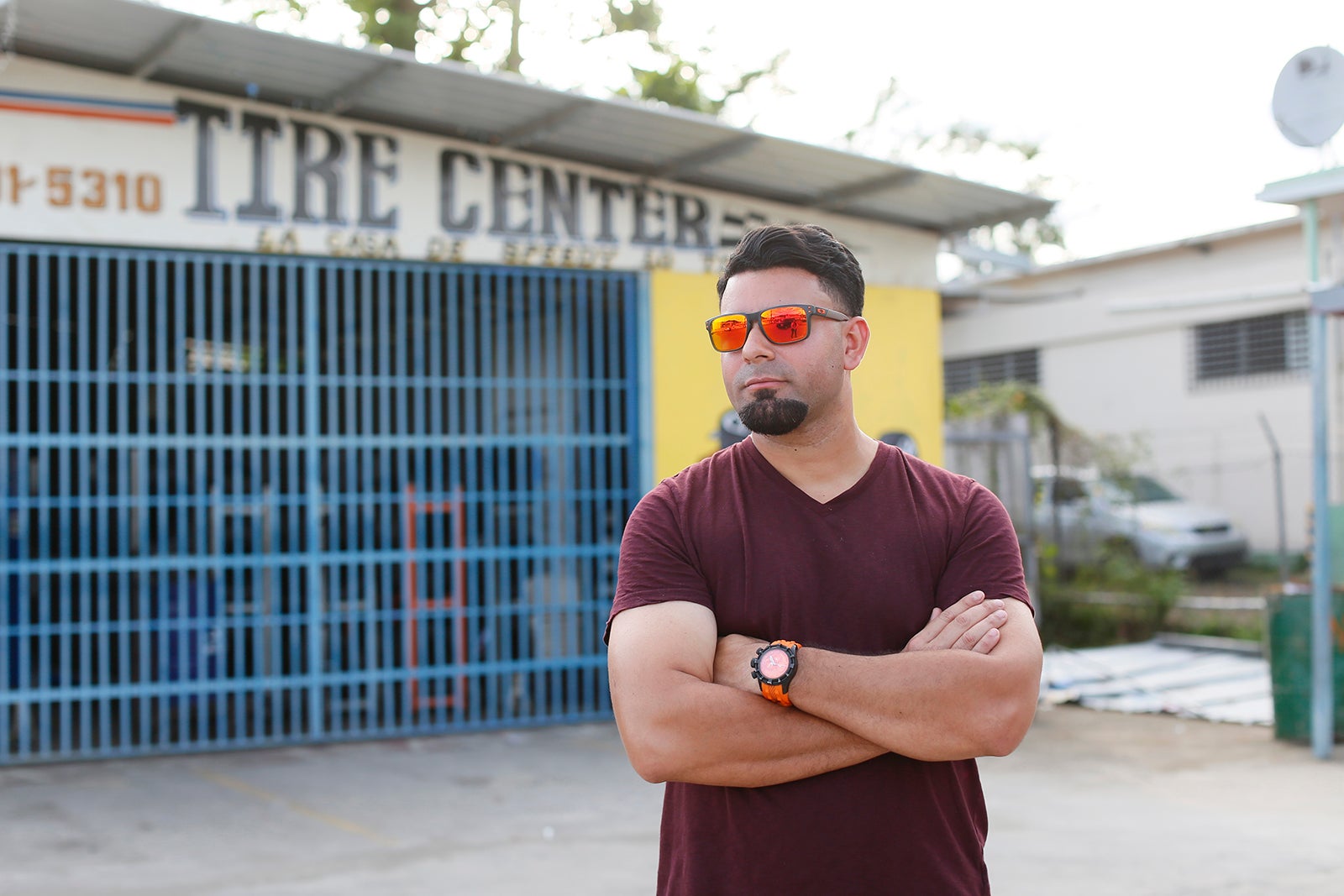Hurricane Maria is Puerto Rico’s chance to finally stand on its own two feet
San Juan, Puerto Rico


San Juan, Puerto Rico
Electrical blackouts wiped every single item from the menu at Double Cake, a trendy bakery in San Juan. But instead of closing, Double Cake’s owners came up with ”pacos,” a cross between a pancake and a taco that they could make without electricity.
The Paco is a product of the disaster wrought by Hurricane Maria. The folded pancake is cooked over a gas grill instead of baked in Double Cake’s storm-disabled electric ovens. It can also be eaten with your hands, eliminating need for forks and washing. Yet the simple paco is as sweet a treat as a decorated cupcake, and is adaptable to whatever filling is at hand: peanut butter, cream cheese, even breakfast cereal.
Double Cake is a tiny business, but the lengths to which its owners have gone to keep it running are indicative of the entrepreneurial drive Hurricane Maria has unleashed in Puerto Rico. From a San Juan lawyer-turned-diesel dealer to the mountain resident who rigged a DIY mobile laundromat, ”people are having to adapt to the new reality,” says Orlando Santiago, one of Double Cake’s owners.
Their ingenuity post-Maria could be the beginning of a long-overdue economic revitalization for the US territory. Decades-old structural problems have kept the broke island from holding its own economically. But the hurricane’s devastation offers Puerto Rico a rare chance to reinvent its economy using a gush of fresh cash in federal disaster aid.
There’s also the risk, however, that the billions of dollars expected to flow from Washington D.C. will only deepen its dependency on the mainland. Like many other things in the island, which direction Puerto Rico takes will largely depend on the faraway lawmakers who hold the purse strings.

A colonial economy, today
Puerto Rico’s precarious economic state before the hurricane was decades, if not centuries, in the making. Once a colony of Spain, the island became a US territory in 1898, and was officially taken out of the United Nations list of non-self governing territories, or colonies, in 1953. Still, in many ways it remains just that, experts argue—a colony.
Throughout the island’s history, external investors have operated as self-contained units within the island, with few contributions to the local economy other than the jobs they create. Back in the first few decades of 1900s, when sugar was Puerto Rico’s top industry, outside plantation owners exported their production, as well as their earnings.
In 1947, local officials launched an ambitious industrialization crusade in hopes of making the island more self-sufficient: Operation Bootstrap. Officials attracted outside capital through generous tax breaks, both at the local and federal levels. The idea was that mainland manufacturers would move operations to Puerto Rico, generating business for local suppliers and passing on their know-how, spawning more local companies, says Deepak Lamba-Nieves, an economic development expert at the Center for a New Economy, a San Juan-based think tank.
What happened was the opposite. Instead of buying raw materials in Puerto Rico, many companies imported what they needed. Just like the sugar plantation owners before them, they sent both the finished product and profits back home.
The island’s fatal co-dependency
Which leads us to another crippling consequence of the Puerto Rican model: its import dependency. Because a big chunk of the island’s farmable land was historically devoted to growing sugar for export, food for locals had to be imported. Today, it still is.
Operation Bootstrap’s industrialization drive further dented the agriculture sector by luring Puerto Rican workers from the countryside into cities. It also increased Puerto Rico’s reliance on other kinds of imported products, since so much of what was manufactured locally was destined to leave the island.
In one case, merchandise produced by in Puerto Rico was even shipped to the mainland before making the return trip to be sold locally—at a steep mark-up, said San Juan mayor Carmén Yulin Cruz in a 2014 interview.
This mismatch between supply and demand, both dependent on the outside, resulted in a wobbly local economy which is unable to sustain itself. It has trouble creating jobs even in the best of times, says José Caraballo Cueto, a University of Puerto Rico professor who has studied the origin of the island’s financial troubles.
Puerto Rico’s escape valves: Welfare and emigration
Elsewhere, this might have toppled the government, or bred the kind of destitute misery that you find in other places in Latin America. But because Puerto Rico is part of the US, its unemployed citizens can easily move to the mainland to get a job, as hundreds of thousands have done in past decades.
Those who stay can survive on food stamps. Nearly 40% of the island’s 3.4 million residents currently get that help, according to the US Department of Agriculture.
These two escape valves kept the Puerto Rican economy churning—until the federal government pulled out the piece that held it all together. In 2006, it ended the tax incentives that had lured mainland manufacturers to the island. Many left, laying off tens of thousands of employees and setting off a debilitating chain of events that sunk the island in a decade-long recession. The loss of jobs spurred the largest exodus of Puerto Ricans to the mainland yet. That, in turn, hurt the businesses that catered to them and reduced tax collections. The government had to borrow just to keep running, until it couldn’t pay back what it owed.
That led to Puerto Rico’s bankruptcy filing in May. Four months later, Maria clobbered what was left of the Puerto Rican economy.
The vicious cycle
The familiar vicious cycle— lost jobs leading to emigration leading to an even weaker economy —is already materializing. Without power, many businesses, including 5,000 small ones (link in Spanish,) remain closed. The number of jobs dipped by 29,000 (Spanish) to 940,000 in October compared with August—there is no solid data for September, due to the hurricane. Another 175,000 employees who haven’t been laid off did not work last month due to hurricane-related complications, according to the Labor and Human Resources Department.
More than 100,000 people have left the island, taking with them purchasing power and taxable income.
An opening for local companies
Yet Puerto Rico is still sputtering along—and may now have a better shot at gaining economic independence than ever before.
The storm has reconfigured the island’s economy around products and services whose demand has suddenly shot up: generators, diesel, purified water, hot food, cold beer. Because of the logistical debacle caused by Maria, it’s been cumbersome to ship in these and other items from the mainland. This is finally giving local firms an advantage—and offering a glimpse of how they could play a bigger role in the island’s economy.
“Companies that produce locally can respond more quickly. Their products can be in the hands of the clients tomorrow vs. the companies that import,” says Jorge Bracero, chief marketing officer of Cervecera de Puerto Rico. The brewer is making the most of the opportunity, donating generators to its clients and sponsoring happy hours so it can sell more beer under a program it’s calling “Restart.”

In the mountain municipality of Utuado, Speedy González Tire Center is an example of how the federal government could boost the island’s debilitated small-business sector by simply buying local. The National Guard, which sits next to the small shop, is using it to service all of its vehicles. Daniel González, its owner, says he’s been making more money after Maria than before.

Federal and state officials could work with locals firms so that the one-time disaster aid funds empower them permanently. But signals from San Juan and Washington D.C. are so far not encouraging.
The local government is taking its usual centralized and bureaucratic route. Last month, governor Ricardo Roselló created a new state agency (Spanish) charged with coming up with a reconstruction plan and managing all the federal, state, and private funds available to carry it out. On top of that, his administration’s management of the power outage, marred by a controversial contract with the tiny, inexperienced firm Whitefish, is undermining its own argument for autonomy.
The Financial Oversight and Management Board, a US president-appointed body that is supervising Puerto Rico’s bankruptcy process, has asked Congress members to make federal aid contingent on the Puerto Rican government adopting board-proposed measures. It’s a worrying prospect for the recovery process, given that the board’s mission has been to slash government spending, not to build up an economy.
Grassroots reconstruction
On the ground, though, there are efforts to fight back the top-down approach. The Center for a New Economy has put together a citizen-led advisory commission (Spanish) to come up with reconstruction strategies to catapult Puerto Rico past its sorry pre-Maria state. The group, which is backed by the Rockefeller, Ford, and Open Society Foundations, is promising a plan by early spring.
“There are American citizens here that need help. The destruction has been massive,” said Lamba-Nieves, the researcher at the think tank. “At the same time, the fact that the federal government is sending us funds shouldn’t mean that they are going to impose a single vision of how they should be used.”
Other local non-profits are moving ahead with programs to buoy Puerto Rico’s small firms, which employ more than 80% of the Puerto Ricans in the private sector, according to the the US Small Business Administration. Their improved fortunes would arguably reverberate throughout the rest of the economy.
You can see the proof of concept back at Double Cake. Its owners are making the most of a $1,600 donation and financial advice from Inprende, a group that promotes entrepreneurs. A few weeks later, they were able to start baking thanks to a subsidized generator lease they got through another local booster, Foundation for Puerto Rico.
They’ve kept on nearly a dozen employees. As they ramp up, they’ll start placing egg and milk orders from their local suppliers, which in turn will do the same, in theory.
Double Cake finally got grid power a few days ago. The blackout’s crushing conditions are fading, but Double Cake is still deploying the business savvy it acquired during that time, says Santiago. ”It prepared us to operate under any kind of circumstances,” he adds.
Pacos, which proved popular, are also staying.